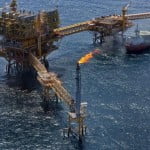The Larsen and Tourbo Ltd (L&T) stock has fallen by 25% since April. Worse, it has underperformed benchmark indices like the S&P BSE Sensex and S&P BSE Capital Goods, especially after the second quarter results.
Obviously, all is not well at the country’s largest infrastructure firm. Since April, Bloomberg has drastically cut analyst consensus estimates of earnings per share (EPS) for fiscal years 2016 and 2017 by 17% and 16%, respectively. L&T’s stock price of Rs.1,280 discounts the 2017 anticipated EPS by about 20 times. This may imply that negatives are factored in.
But given the slow pickup in engineering and construction at a macroeconomic level, the moot question is, how long will it take before the juggernaut gains traction. Forecasts on the bourse are subdued for the near to medium term.
First, there is little to cheer about order inflows. Even after the management recently cut fiscal year 2016 estimates from 15% to 5-7%, analysts are open to an even lower growth. After the first six months, L&T still needs a 33% year-on-year growth in the second half to fulfil its guidance. That is near-impossible. Moreover, tumbling crude oil prices and weak commodity prices put its Middle-eastern operations at risk. The outlook for hydrocarbons, power, metallurgy and material handling will take several quarters to improve.
Second, project execution, which has been L&T’s forte, is crawling due to delays and, in some cases, financial constraints at the customer’s end. After a lacklustre 6% growth in its key division—engineering and construction—in October, the management watered down revenue guidance for fiscal year 2016 to 10-15% from 15%.
A Nomura report says that from fiscal year 2011, L&T embarked on an asset-heavy business model from an asset-light one. These investments being largely debt-financed have delivered decent revenue and operating profit growth but failed to deliver profit growth. The firm is indeed trying to steer into engineering, procurement and construction projects instead of the build-operate-transfer model, to improve cash flows.
Third, high fixed costs and more work-in-progress have taken a toll on profitability. In October, the operating margin fell nearly 300 basis points to 7.6%. It is among the largest road concessionaires, but these projects are yet to break even. Challenges in large, long-gestation projects like the Hyderabad Metro are certainly a drag on its margins. One basis point is 0.01%.
In fact, in the last few quarters, L&T’s positive drivers have been the non-engineering segments like information technology and financial services. The firm has, in the last couple of years, exited or sold stakes in some non-core businesses to unlock value. But some segments in the gigantic firm remain a drain on profits. At the end of the day, selling loss-making or troublesome assets is not easy either in a buyer’s market, as is the case today.
Fiscal year 2016 could be one of the most challenging years for L&T. The steep fall in stock price has certainly reduced downsides. But margin recovery, apart from order inflows, is a must for investor confidence to return. This might take a few quarters more.
[“source -livemint”]





